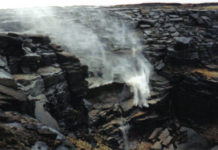For more than four centuries adventurers have sought the legendary city of El Dorado in the mountains and jungles of South America. It has never been found, for it did not exist, and yet the power embodied in the tale of a place of inestimable riches remains undiminished. People have been obsessed with gold since it was first discovered. This is partly due to its rarity: the total gold mined in all the world to date amounts only to some 170,000 tons. Gold is also one of the most constant metals, neither corroding nor tarnishing, therefore, it has long been the choice of kings, the ultimate measure and symbol of wealth.
This association with riches beyond man’s wildest dreams guaranteed its place in fact and fiction, but gold has also acquired mythic status. The most potent golden legend – that of the fabulously wealthy city of El Dorado, where even the cooking pots were made of gold – has attracted generations of adventurers to South America. All have been disappointed since they were drawn by a myth.
Like most myths, the story of El Dorado has some basis in fact, and its genesis can be dated fairly precisely. When Christopher Columbus returned from his voyage of discovery in 1493 with tales of limitless supplies of gold, he unleashed gold fever in Europe. Within 50 years, the enormous stocks of gold belonging to the Aztecs of Mexico and the Incas of Peru had been plundered by the conquistadors.
No one in Europe who witnessed the unloading of ships stacked high with golden artefacts, ingots (for many objects were melted down before transportation) and gemstones can have doubted that there was wealth for the taking in the New world. Tales of the conquistadors’ good fortune were legion. In 1532, for example, Francisco Pizarro held the Inca emperor Atahualpa to ransom for a roomful of gold and two of silver. Although the demands were met, the emperor was still put to death.
In 1538, the Spanish entered the territory of the Muisca people and founded the city of Bogota. Here they heard of the traditional ceremony performed on the shores of Lake Guatavita to the north-east to acknowledge a new Muisca king. Furthermore, it was claimed that there were people still living who had witnessed the last occasion when a king had been so honoured.
The men who travelled to South America may have failed to locate a city of gold, but there was gold, and plenty of it, in the tombs and temples of the New World. The Muisca and other peoples had for centuries made golden masks of their leaders, many of which were encrusted with gemstones, particularly emeralds for the eyes. Although enormous numbers of masks and other artefacts were melted down into ingots before shipment back to Europe, many escaped the conquistadors’ grasp.
The ceremony took place at dawn so that the king and his entourage could salute the sun god. At the designated moment, the naked king was covered in gold dust so that he became, literally, a golden man, el dorado. He was placed on a rush raft, while courtiers arranged gold and emeralds at his feet for him to offer to the sun god. Four chiefs, also naked except for golden crowns, bracelets and other jewelry, joined him on the raft, each carrying an offering. When the raft reached the middle of the lake, a banner was raised as a signal for silence, whereupon the king and his chiefs cast their offerings into the waters.
Surrounded by desolate hills, Lake Guatavita, the favoured location for the mythical city of El Dorado, is situated some 30 miles (50km) north-east of the Columbian capital, Bogota. On one bank the lake still bears the scars of Antonio de Sepulveda’s attempts to drain it in the 1580s. the lake was once sacred to the local Muisca people, who made offerings to a former chieftain’s wife, said by legend to dwell in the depths of the lake with a terrible monster.
The prospect of so much treasure within apparently easy reach gripped the Spanish imagination. In 1545 an attempt to dredge Lake Guatavita yielded nothing. Undeterred, in the 1580s a Bogota merchant, Antonio de Sepulveda, tried to drain it. With a labour force of 8000 Indians, he managed to cut a huge swathe in the shoreline, which is visible even today. A surge of water lowered the level of the lake by about 60ft (18m) before the banks collapsed, killing many of the labourers in the process. Sepulveda was partially successful, however, and King Philip II of Spain was presented with a gold breastplate and staff as well as an emerald the size of a hen’s egg, found in the lake.
A century later the story started to change. As the tale was retold with embellishments, El Dorado ceased to be a person and became a place. In addition, its location shifted, first to the lower Orinoco, then to the Amazon, some 1500 miles (2400km) from Lake Guatavita. This was the legend that tempted the Englishmen Walter Raleigh and Colonel Percy Fawcett, the Spaniards Gonzalo Jimenez de Quesada and Sebastian de Belalcazar and the German Nicolaus Federmann to try to locate the golden city.
Lake Guatavita became the focus of renewed – largely fruitless – activity after 1799, when a party of scientists led by the Prussian Alexander von Humboldt spent three months tracing the course of the Orinoco River, which for part of its length flows along the Columbia-Venezuela border, deep inside the territory that had originally spawned the myth. Reports of the lake’s existence brought a fresh wave of adventurers to the area. When Humboldt later publicly calculated that 500,000 gold objects must lie at its bottom, the search began again.
It seems likely that the vast majority of gold and jewels deposited in Lake Guatavita during the ‘golden man’ ceremony went into the Spanish treasury in the 16th century. Certainly the last major attempt to drain the lake, in 1912, yielded only a few small ornaments whose worth in no way compensated for the engineering costs. Those who searched for the city of El Dorado, on the other hand, were doomed to failure: in spite of the volumes dedicated to describing it, the golden city never existed.
A solid gold model depicting the ceremony of ‘the golden man’ was found by two farmers in a cave near Bogota in 1969. It was similar to a piece recovered from Lake Siecha, near Guatavita, n 1856. Such finds ensure that the legend of El Dorado lives on.
-end-




































